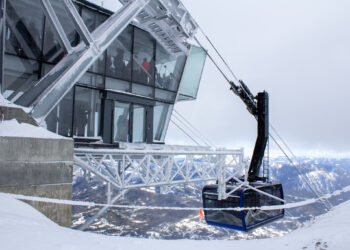Big Sky is growing – big time. Again.
By Eric Ladd EBS Publisher
Big Sky, Mont., is an idyllic setting surrounded by snowcapped peaks, rolling forested hills, diverse animal species and rushing, clear mountain streams. It’s no wonder so many people have discovered this universal sweet spot and now call it home. It’s no wonder this little mountain town is currently host to more than $1 billion in new construction with an estimated 3,000 new homes and 11 new hotels in process.
Big Sky is growing – big time. Again.
Big Sky has been a boom-bust town since it’s inception by Chet Huntley in 1973. Most recently, under new, well-funded leadership, an aggressive growth trajectory has been launched.
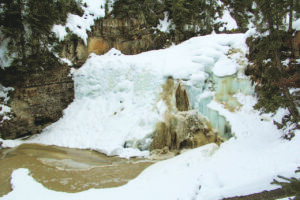
Big Sky developers have had a colorful relationship with groups like the Environmental Protection Agency and the Department of Environmental Quality as they’ve worked to carve a resort community into this mountain valley in the shadow of Yellowstone National Park. The question of how Big Sky will sustainably evolve is being asked in earnest by the resilient mountain community members who have struggled without organized leadership for 43 years.
On Thursday, March 3 a leak was reported at the Yellowstone Club’s wastewater retention pond that lasted for more than 90 hours, leaking approximately 30 million gallons of effluent into a small tributary of the Gallatin River.
The South Fork of the West Fork of the Gallatin is a treasured stretch of water that includes the cherished native westslope cutthroat trout, cascading waterfalls including the prized Ousel Falls, and well-traveled animal corridors all connecting to the Gallatin River watershed.
Many people cried foul when this stream was shaken out of its winter hibernation by sediment laden effluent water. While it appears the community may have dodged a bullet in terms of far-reaching environmental damage from the March 3 accident, it will take weeks and perhaps months to fully understand impacts to the river and its inhabitants.
Explore Big Sky staff produced this special section to help educate our community on the facts surrounding the leak and start a discussion about our community infrastructure and our impact on this region as humans.
At EBS, our staff remains committed to responsible reporting that not only shares the facts but also helps build community through education and thoughtful discussion. Our heartfelt thoughts go out to all those impacted by this tragic event including the species with voices we are unable to hear.
“In the end, we will conserve only what we love; we will love only what we understand and we will understand only what we are taught.” – Baba Dioum
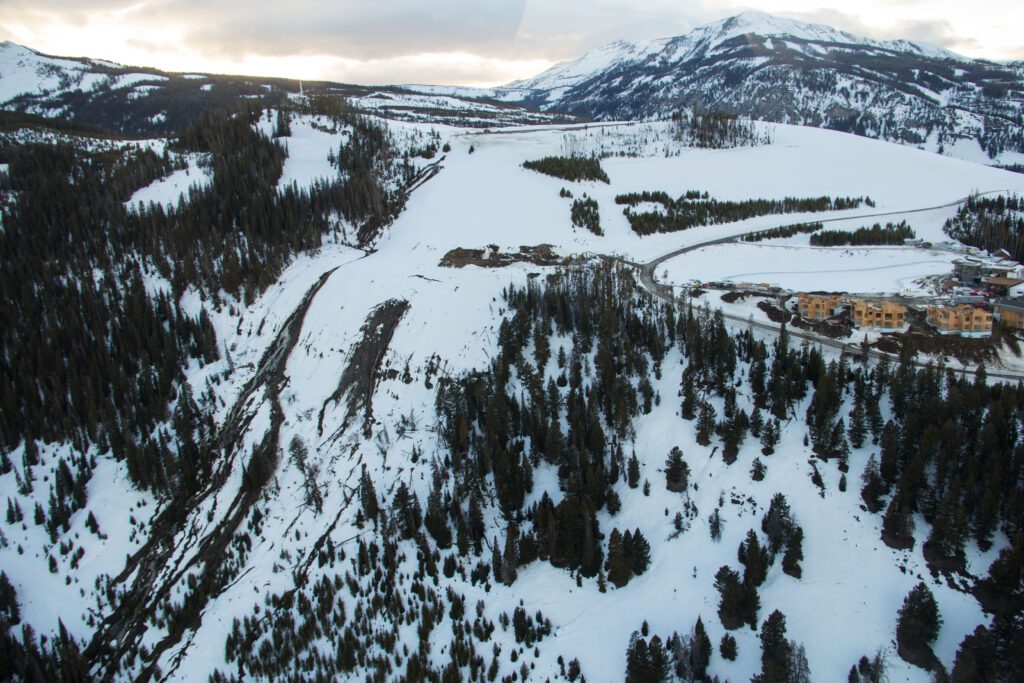
Yellowstone Club wastewater pipe breaks
Thirty million gallons of treated effluent pours into Gallatin watershed
By Joseph T. O’Connor and Amanda Eggert EBS Staff
BIG SKY – In a 1999 High Country News story called “Affluent effluent stinks, too,” Joe Kolman wrote about wastewater seeping illegally into the ground in the Gallatin River watershed.
“…In the future, some treated sewage will most likely be dumped back into the Gallatin River. That day is far off – perhaps in the year 2015 – but by then this unincorporated community, centered around Boyne USA’s Big Sky Ski and Summer Resort, could be a part-time or full-time home to almost 8,000 families. The thought of its affluent effluent flowing into the Gallatin River has created a stink.”
Fast forward to the year after the ominous prediction: 2016. On  the morning of March 3, effluent from a broken drainpipe on an 80-million gallon wastewater retention pond began cascading down a hillside at the Yellowstone Club, a private resort community in Big Sky. The 35 million gallons the pond held at the time began carving deep trenches in the hillside en route to Second Yellow Mule Creek, which joins the South Fork of the West Fork of the Gallatin River.
the morning of March 3, effluent from a broken drainpipe on an 80-million gallon wastewater retention pond began cascading down a hillside at the Yellowstone Club, a private resort community in Big Sky. The 35 million gallons the pond held at the time began carving deep trenches in the hillside en route to Second Yellow Mule Creek, which joins the South Fork of the West Fork of the Gallatin River.
By 5 p.m. that evening, the confluence of the West Fork with the main stem of the Gallatin was turned a murky brown. The discharge continued for three more days, dumping approximately 30 million gallons of effluent into the Gallatin, transforming the gin-clear water into a chocolate milk color.
The wastewater, 30 million gallons of which the Big Sky Water and Sewer District piped up to the Yellowstone Club for irrigation on the club’s pristine golf course, is treated effluent – far from raw sewage, but not potable. From a helicopter on the evening of March 6, the clear water was seen rushing down the hillside picking up heavy amounts of sediment and depositing it into Second Yellow Mule.
The color comes from erosion and sediment washed into the South Fork of the West Fork of the Gallatin, according to Kristin Gardner, executive director for the water quality nonprofit organization Gallatin River Task Force.
The Yellowstone Club first reported the breech to the Montana Department of Environmental Quality the afternoon of March 3, and upon further inspection, the club theorized that the broken pipe resulted from ice that formed this winter after workers attempted to fix a previous leak in the pond liner.
In fall 2015, the club drew down the effluent water level in the pond to fix the leak in the liner, according to Mike DuCuennois, vice president of development for the Yellowstone Club. As the Big Sky Water and Sewer District pumped water back into the pond from its sewer plant in the Meadow Village beginning in December, ice formed on the drainpipe at the bottom of the pond.
The pond’s water level continued to rise and the iced-over pipe began pulling out of the pond bottom, ripping the liner and breaking the pipe, DuCuennois said.
Beginning on March 4, agency representatives from around the state and county responded to the incident, and included the state DEQ, Department of Public Heath and Human Services, Gallatin County Health Department, and Fish, Wildlife and Parks. A number of other organizations convened at various river locations to perform testing throughout the weekend. Gallatin River Task Force is assisting the Yellowstone Club with testing.
Through the weekend and into Monday, March 7, Montana DEQ tested the stream water for sediment concentration levels as well as nitrogen, phosphorus, ammonia, pharmaceuticals, nitrate plus nitrite, and total nitrogen. With the exception of sediment levels, those results were not available as of EBS press time on March 7.
Turbidity readings, which help determine sediment levels, were made available in a press release obtained by EBS. Suspended sediment has emerged as one of the leading threats to aquatic life in the watershed, since high levels of suspended sediment compromise trout and other fish species’ ability to breathe. The impact becomes more pronounced the longer the fish are subjected to heavy sediment loads.
Kristi Ponozzo, Montana DEQ’s public policy director, wrote in a March 7 email that “turbidity is lowering in the creeks closest to the source while the turbidity in the surface water further away is increasing slightly. According to the sampling team, this is normal as the turbidity in the streams closest to the point of discharge slowly clear and sediment moves downstream.”
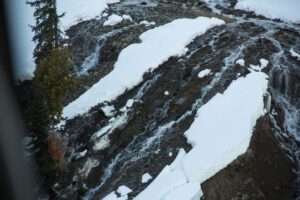
Readings were taken March 5 and 6 at Second Yellow Mule Creek, the South Fork of the West Fork, the West Fork and the main stem of the Gallatin. Most sample sites indicate that turbidity had decreased significantly from March 5 to March 6. GRTF’s Gardner said a high-flow spring runoff event would eventually flush much of the sediment downstream.
The highest turbidity reading was taken at Second Yellow Mule Creek, the first creek to be impacted by the wastewater. The DEQ measured 1686 neophelometric turbidity units (NTUs) on Saturday and 740 NTUs on Sunday.
The DEQ also took readings at several sites not impacted by the spill to obtain background data. The highest of those readings was 4.3 NTU, within the DEQ’s established threshold of 5 NTUs.
“There was a huge blowout of sediment, and that’s bad for the river,” said Guy Alsentzer, the founder and executive director of Upper Missouri Waterkeeper. “Contextually, we’re going to have to look at what’s happening on the fisheries, whether or not fine-grain sediment have smothered fish habit at where spawning fish would be laying their eggs.”
at where spawning fish would be laying their eggs.”
After learning about the spill on March 3, Wade Fellin, the program director of Upper Missouri Waterkeeper, went to the Gallatin and collected samples from four locations on the Gallatin: near The Corral Bar and Steakhouse, which is upstream of the West Fork and should not be impacted by the spill; the confluence of the West Fork with the main stem of the Gallatin; a site 1.7 miles downstream of the confluence of the West Fork with the main Gallatin; and House Rock, approximately 14 miles north of the confluence.
Upper Missouri Waterkeeper sent the samples to Bridger Analytical Lab in Four Corners. Nutrient levels – specifically chloride, nitrate, nitrite, and phosphorus – did show up in the samples, but not at levels that would cause an acute fish kill, he said.
“The river has dodged a bullet to the face,” Alsenzter said, adding that one key piece of data is not back from the lab yet. He’s still awaiting results on Biochemical Oxygen Demand, a five-day lab test that will paint a better picture of the dissolved oxygen available to aquatic life.
He received test results for E. coli and found a count of 91 MPN/100mL at the confluence of the West Fork with the Gallatin. MPN stands for “the most probable number of bacteria in the sample” and is roughly equivalent to a parts per million reading.
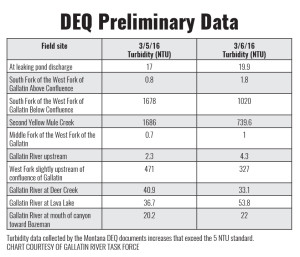 To provide context for comparison, Alsentzer said that the Ennis wastewater treatment facility has an established threshold of 125 MPN/100mL, but said its presence is never welcome in the waterway and indicative of wastewater entering the Gallatin.
To provide context for comparison, Alsentzer said that the Ennis wastewater treatment facility has an established threshold of 125 MPN/100mL, but said its presence is never welcome in the waterway and indicative of wastewater entering the Gallatin.
“Basically, any presence of E. coli is considered dangerous,” said Peter Manka, a water resource engineer with Alpine Water in Big Sky. “Anytime you have any presence of E. coli [it’s] a red flag.” He added that deer feces in the river could cause a spike of E. coli in a water sample.
Alsentzer said it’s significant that there was no detectable E. coli in the sample he took upstream of the confluence.
According to Ron Edwards, general manager at the Big Sky Water and Sewer District, these test areas aren’t necessarily indicative of the water flows coming out of the West Fork of the Gallatin.
“The whole canyon is septic systems and drain fields,” Edwards said. “The [results] could be easily coming from there.”
Edwards noted that initial DEQ tests of the wastewater in the holding pond indicated a residual chlorine level of 0.16 parts per million. “That will kill all bacteria,” he said.
At a March 4 public meeting to update the Big Sky community on the spill, county health officials advised concerned citizens to have their wells tested.
“We’re prepared to pay for all well testing in the watershed,” said Matt Kidd , principal with CrossHarbor Capital Partners, the majority owner of YC. “We’re willing to do whatever it takes to make it right.” A webpage informing community members about the spill said the YC would cover the lab cost of all well water sampling for the next 12 months.
As of EBS press time, fines had not been levied against the Yellowstone Club or BSWSD – a “long process” according to an email from Ponozzo. “We know, right now, that there are Water Quality Act violations for turbidity [and] there
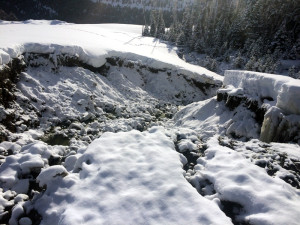
may be other violations based on this event.”
“DEQ is focusing our efforts right now on water quality monitoring and remedy of the situation,” the email continued. “We won’t have any sort of ideas for the amount of fines until we get further into the enforcement action process.”
Jim Jensen, executive director of the Montana Environmental Information Center, said such Water Quality Act violations could total up to $1,000 per day of violation, but “they never fine the maximum.” He said he’s concerned that B
SWSD personnel were aware of the 2015 leak in the pond, but didn’t report it to DEQ. “The DEQ was not aware of the leak, and they should have been.”
At the public meeting on March 4, DuCuennois said the leak was small enough that they were not required to notify the DEQ.
For his part, Edwards said the incident has brought into sharp
relief the need for other wastewater treatment solutions for the community. “The two options we’ve got for disposal rely on outside entities, the Yellowstone Club golf course and Big Sky Resort golf course, and that’s not a good situation for us. So we’ll be talking about it more at our board meetings going forward,” Edwards said.
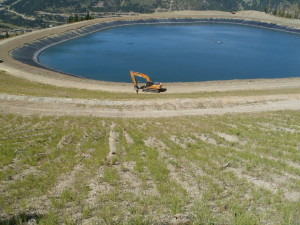
Alsentzer said its essential that the Big Sky community uses this unfortunate event to take a look at the intersection of increasing growth and strained infrastructure in Big Sky. The current sewer system is technologically outdated and “completely strapped,” he said. “How are we going to upgrade? How are we going to plan for the future so nothing like this will ever happen again?”
The YC has launched a webpage to inform community members about the leak at yccommunityinfo.com. The Gallatin River Task Force has also launched a page dedicated to the spill at gallatinrivertaskforce.org/yellowstone-club-spill. The Big Sky Water and Sewer District outlined a day-by-day summary of the incident that is available at bigskywatersewer.com.
Q-and-A: Charles Wolf Drimal
Wild and Scenic designation proposed for Gallatin River
By Tyler Allen EBS Senior Editor
Charles Wolf Drimal is a waters conservation associate for the Greater Yellowstone Coalition, which is on the steering committee for Montanans for Healthy Rivers, along with American Rivers, American Whitewater, the Pacific River Council and Backcountry Hunters and Anglers. The coalition also includes watershed groups like the Gallatin River Task Force, as well as businesses and private landowners throughout the state.
The group has identified about 500 miles on more than 50 rivers in the state that are eligible for Wild and Scenic designation. In the Big Sky area, Montanans for Healthy Rivers has identified river segments on public land like the upper Gallatin River, Taylor Fork and Porcupine Creek as candidates for protection under the Wild and Scenic Rivers Act.
“Something that is important for people to really understand is that we live in a really fragile ecosystem,” said GRTF Executive Director Kristin Gardner. “We have to be very careful and really take care of it.”
With developer estimates that Big Sky is only 30 percent built-out, and the remaining 70 percent of development is projected to happen within 10 years, protecting the Gallatin from future impacts will necessitate strategies like the Wild and Scenic Rivers Act.
Explore Big Sky: How long has Montanans for Healthy Rivers been actively pursuing designation of the Gallatin as Wild and Scenic?
Charles Wolf Drimal: Montanans for Healthy Rivers started a little over five years ago examining rivers that were eligible … and that included the Gallatin River to our early assessment.
EBS: From your perspective, what’s the greatest motivation for a Wild and Scenic designation of the Gallatin?
CWD: The Gallatin River is a remarkable river and resource for the Big Sky and Bozeman communities – it’s also regarded as the river that people come to from all over the world to fish and float. And so I think that there’s a huge sense of pride to protect the Gallatin River as it is.
EBS: What would be the greatest benefit of designation to the Gallatin?
CWD: The Gallatin would forever remain free flowing, so no future proposals to impound or dam the Gallatin could be even considered; the water quality of the Gallatin would have to be maintained or enhanced; and all the remarkable values associated with the Gallatin such as fisheries and wildlife, recreation and scenery … would have to be protected and maintained by the Forest Service through management.
EBS: Big Sky’s wastewater treatment facilities are near maximum capacity, and some community members want to release treated effluent into the Gallatin here in Big Sky, as is done in Bozeman. Would a Wild and Scenic designation affect that possibility?
CWD: Speaking on behalf of the Greater Yellowstone Coalition, we are insistent on non-degradation of the Gallatin River in terms of its chemistry and … water temperature. We’re also actively working with businesses in Big Sky through an emerging … watershed partnership group to address water treatment and address water use throughout the Gallatin watershed.
EBS: Does this incident create any added motivation to get the Gallatin designated Wild and Scenic?
CWD: No one wants to see things like this happen in the future. [The Wild and Scenic Rivers Act] supports wildlife and fisheries, and in terms of the future development within places like Big Sky, it elevates the consciousness of how to … use the best available technology for building and for water municipal water infrastructure.
EBS: Where is the process at currently for designating these Montana rivers as Wild and Scenic?
CWD: We are now actively building endorsements for [our June 2015] draft citizen proposal … our steering committee that’s made up of both sportsmen and conservation groups in Montana has been actively working with the Montana delegation to push for a formal legislative bill to be introduced in Congress.
EBS: What do you think is the greatest hurdle to Wild and Scenic designation for Montana rivers?
CWD: Ultimately, the stalemate that we’ve seen for the last three and a half years in Congress. I think that having a full Montana delegation in support of river protection, that is bipartisan, shows that there’s interest in moving a future bill through Congress. I don’t think that the hurdle is from within Montana for future designation.













